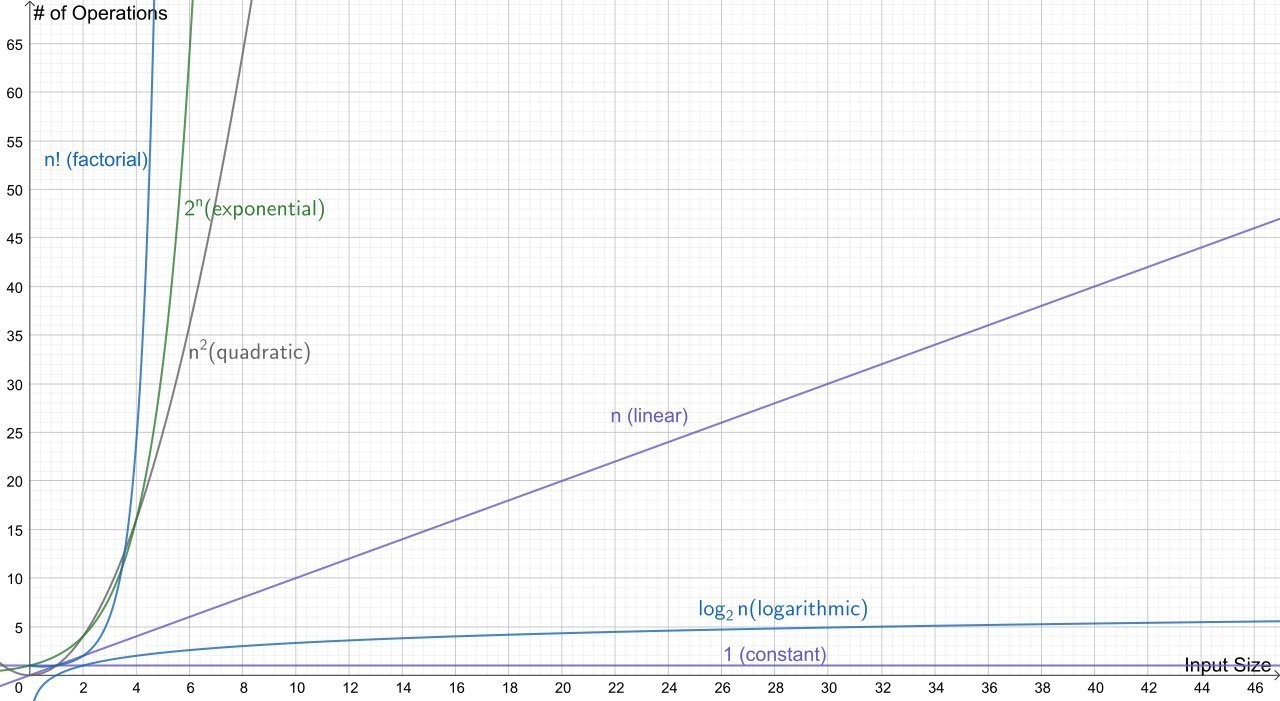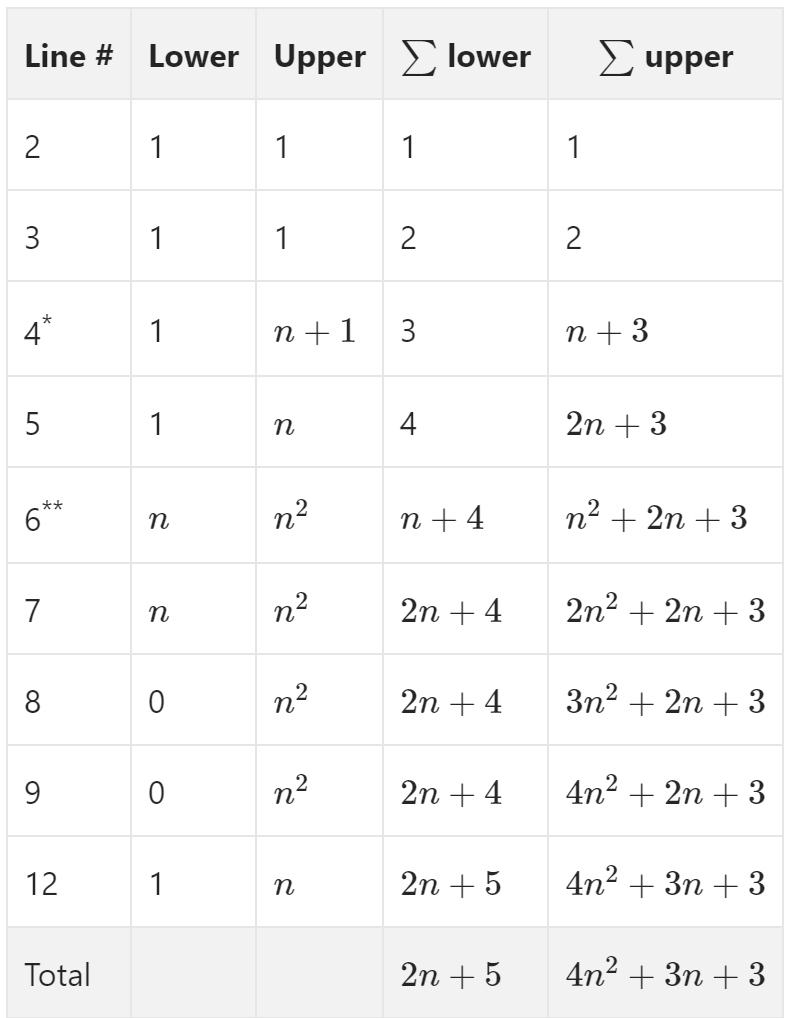Algorithm Analysis:
Asymptotic Complexity
Agenda
- Prerequisites
- Why is the Analysis of Algorithms important?
- What's the goal of Asymptotic Complexity?
- What are we really measuring?
- RAM computational model
- Machine Operations as a Function
- Asymptotic Complexity
- Asymptotic Notation (Θ, O, Ω)
Prerequisites
- Basic Programming
- Basic Algebra
- Mathematical Functions
- Graphing
- Logarithms
- Set Notation (helpful)
Why is the Analysis of Algorithms Important?
- Foundational concept for computation
- Design performant algorithms
- Understand language primitives
- Develop an intuition for scale
- Identify intractable problems
- Learn patterns and techniques from the "greatest hits" of programming
- Poorly taught in academia
- Impetus for my book (https://hideoushumpbackfreak.com/algorithms/)
Litmus Test
If you think you don't need it, or you know it and never use it, you most likely need to study it.
What's the Goal of Asymptotic Complexity?
- Performance-centric analysis (sort of...)
- Why not measure clock time?
- Machine variation
- Input size must be a factor
- Concisely express how an algorithm will scale without regard to a particular physical machine
- Simple means for comparing algorithms
- "[Asymptotic Complexity] significantly simplifies calculations because it allows us to be sloppy – but in a satisfactorily controlled way" - Donald Knuth
- Theoretical framework for advanced algorithm analysis
What are we measuring?
- Approximate number of Machine Operations
- It's not practical to measure the actual number of machine operations
- Programming language variations
- Machine variations
- Parallelism
- Radom Access Machine (RAM) Model
- Not to be confused with Random Access Memory
Random Access Machine (RAM)
- Theoretical computing machine
- Algorithm Comparisons independent of a physical machine
- Runs pseudo code
- Assumptions
- Sequential execution of instructions
- Fixed word sizes
- Standard integer and floating-point numbers
-
Operations (loosely defined)
- Arithmetic (add, subtract, multiply, divide, remainder, floor, ceiling)
- Data Movement (load, store, copy)
- Control (conditional branch, unconditional branch, subroutine call, return)
RAM Operations
1 data operation
1 control operation X 3 iterations
1 arithmetic and 1 data operation X 3 iterations
1 control operation
Total = 12 operations
If we are being pedantic, this is how to count operations...
1 control operation
j ← 0
for i∈{1,2,3} do
j←i × 2
end for
return jRAM Operations
- An operation is roughly equivalent to an executed line of pseudo code
- It's acceptable to take reasonable liberties
\( d \gets \sqrt{(x_2 - x_1)^2 + (y_2 - y_1)^2} \)
1 operation
1 operation X 3 iterations
1 operation X 3 iterations
1 operation
ignore
1 operation
How do machine operations relate to scale?
j ← 0
for i∈{1,2,3} do
j←i × 2
end for
return jTotal = 8 operations
Machine Operations as a \( f(x) \)
- When considering scale, growth rate in relation to input size is what's important
- Mathematical function describing the relationship between operations and input size
- Input Size
- Could be anything: number of bits, a scalar value, etc...
- Typically number of items: elements in array, nodes in graph, etc...
- Conventions
- Input size = \( n \)
- Growth rate function = \( T(n) \)
\( T(n) \) Example
function square(A)
for i ← 0 to |A| −1 do
A[i] = A[i] x A[i]
endfor
end function1 operation per item
1 operation per item
Total = 2 operations per item
\( T(n) = 2n \)

More Complex \( T(n) \)
- Not all algorithms can be expressed by a single \( T(n) \)
- Upper Bound
- Lower Bound
function findDuplicates(A)
D←∅
for i←0 to |A| −1 do
for j←0 to |A| −1 do
if i≠j and A[i] = A[j] then
D←D ∪ {A[i]}
end if
end for
end for
return D
end function1 operation
\( n \) operations
\( n^2 \) operations (\( n \) per item)
\( n^2 \) operations (\( n \) per item)
Between 0 and \( n^2 \) operations
1 operation
Upper Bound
Lower Bound
Comparing \( T(n) \)

Under reasonable assumptions, square scales much better than findDuplicates
Asymptotic Complexity
Review: The goal is to concisely express how an algorithm will scale (growth rate)

Loosely consider the asymptotic complexity to be the "shape" of \( T(n) \)
Deriving Asymptotic Complexity
Remove all constants and non-leading terms
Constants
Non-Leading Term

The "shape" does not change
6 Basic Complexity Classes
| Name | Growth Rate | Example |
|---|---|---|
| Constant | Hash Table (Look up) | |
| Logarithmic | Binary Tree (Search) | |
| Linear | Linked List (Search) | |
| Quadratic | Bubble Sort | |
| Exponential | Traveling Salesman (Dynamic Programming) | |
| Factorial | Traveling Salesman (Brute Force) |
Asymptotic Complexity Shapes

What does Asymptotic Complexity Really Say?
- Larger asymptotic complexity values equate to longer run times given that the input size is sufficiently large.
- Consider two theoretical algorithms
- \( \sigma - T(n) = n^2 \) - asymptotically quadratic
- \( \alpha - T(n) = 50n \) - asymptotically linear
Question: Does the linear algorithm always execute fewer machine operations?
What does Asymptotic Complexity Really Say?
Answer: No, for values of \( n \) lower than 50, \( \sigma \) has fewer operations that \( \alpha \)

Asymptotic Complexity
One Last Time:
The goal is to concisely express how an algorithm will scale (growth rate)
Asymptotic Notation
- Known as Landau Symbols outside of CS
- Express asymptotic concepts concisely
- \( \Theta \) - Big Theta
- \( O \) - Big O
- \( \Omega \) - Big Omega
\( \Theta \) - Big Theta
-
Asymptotic Tight Bound
- Asymptotic complexity is the same regardless of input
- It’s not possible to specify \( \Theta \) for all algorithms
- Recall findDuplicates
- Lower Bound \( T(n) = 3n^2+n+2 \)
- Upper Bound \( T(n) = 2n^2+n+2 \)
- Asymptotic complexity for upper and lower is \( T(n) = n^2 \)
- findDuplicates = \( \Theta(n^2) \)
\( O \) - Big O
- Asymptotic Upper Bound
- Worst Case Scenario
- O stands for Order of or more precisely the German word Ordnung
- \( \Theta \) is a stronger statement than \( O \)
- if findDuplicates = \( \Theta(n^2) \) then findDuplicates = \( O(n^2) \)
- Big O makes no indication of the best case scenario
\( \Omega \) - Big Omega
- Asymptotic Lower Bound
- Best Case Scenario
- \( \Theta \) is a stronger statement than \( \Omega \)
- if findDuplicates = \( \Theta(n^2) \) then findDuplicates = \( \Omega(n^2) \)
- Big \( \Omega \) makes no indication of the worst case scenario
Example Analysis
function bubbleSort(A)
sorted ← false
index ← |A| − 2
while sorted is false do
sorted←true
for i ← to index do
if A[i] > A[i + 1] then
swap A[i] and A[i + 1]
sorted ← false
end if
end for
index ← index - 1
end while
end function
Lower \( 2n + 5 \) \( \Omega(n) \)
Upper \( 4n^2 + 3n + 3 \) \( O(n^2) \)
* Continues to loop until the for loop on line 6 makes a complete revolution without triggering the if statement on line 7. The extra operation is the exit condition (sorted is true)
** The number of iterations is reduced by 1 for each iteration of the outer loop by virtue of line 12. So it’s technically \( \sum_{i=1}^{n} i \) ; however, this is a bit of minutia that’s best left rounded up to \( n^2 \).
Thank You!
- If you liked this content, let me know and I'll make more
- If you hated this content, let me know and I'll do better
Asymptotic Complexity
By Dale Alleshouse
Asymptotic Complexity
- 1,717



